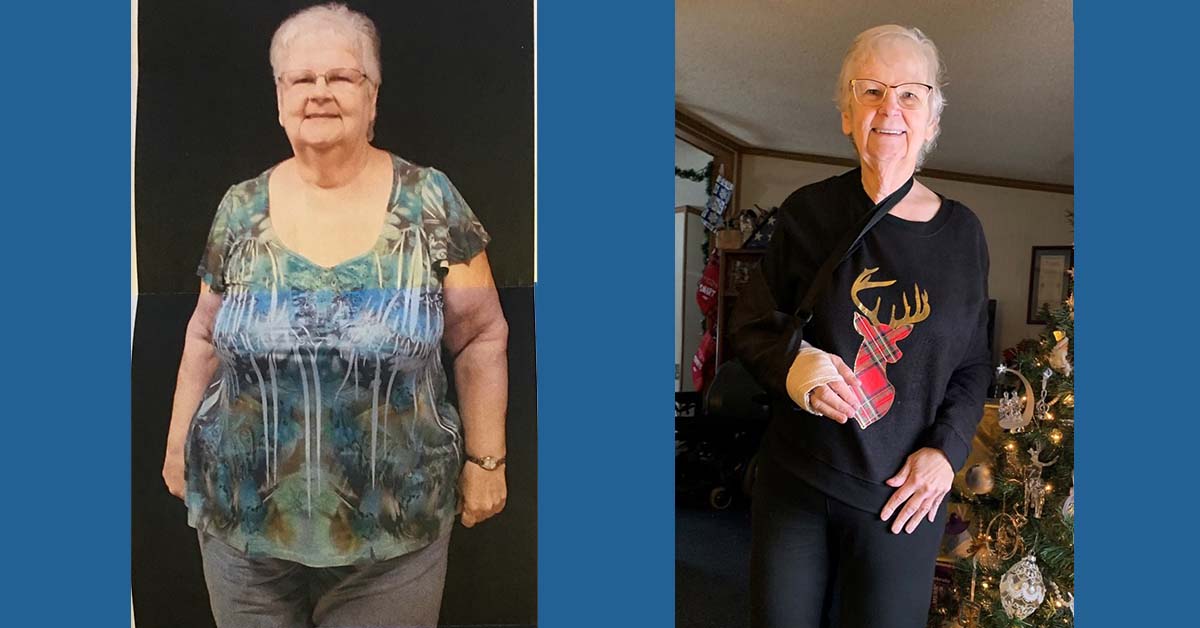“There’s nothing more we can do.”
Those were the words Barbara Wilmot heard as she visited a doctor, seeking relief from back pain caused by spinal stenosis, a condition that causes the spinal canal to narrow and pinch the spinal cord or the nerves around it.
“There’s nothing more we can do.”
Those words meant the 72-year-old would continue to live a life wracked with pain, cramping, weakness and numbness.
“Whenever I would stand or try to walk or do anything, the pain would build in the back so bad I had to sit down because if I didn’t, I felt like my legs were going to give out on me,” Barbara says.
“It came to the end of the rope where the last doctor I saw said, ‘there’s nothing more we can do.’”
But there was more that could be done. Dr. Gerald W. Eckardt, a neurosurgeon with BayCare Clinic Neurological Surgeons, offered a solution.
“When I saw Dr. Eckardt, he said yes, you need back surgery, this is your problem and this is what we can do about it, but you need to lose weight first before we can do the surgery to lower your BMI because right now it’s too high,” Barbara says. “And he said I’m referring you to weight loss surgery.”
Eckardt referred Barbara to Dr. Daniel McKenna, a bariatric surgeon with Aurora BayCare General & Vascular Surgery.
At the time, Barbara weighed more than 280 pounds. She wasn’t pleased she would have to lose weight before having back surgery. She wanted a more immediate remedy.
“I really kind of kicked and screamed and protested that I don’t want weight loss surgery,” she says. “I didn’t want it 10 years ago, so I didn’t want it now.”

She quickly changed her mind, though.
“The neurosurgeon told me that if I didn’t have the (back) surgery at some point and time it could paralyze me,” Barbara says. “So that was kind of the wake-up call to say that you can’t put this off any longer and have to do this, like it or not.”
Barbara lost weight, almost 40 pounds. It was a good start but still wasn’t enough to allow for back surgery.
McKenna performed Roux-en-Y gastric bypass surgery on Barbara in December 2018. The procedure creates a smaller stomach to restrict the portion size of food. Patients experience a decrease in appetite lasting for about one year, further aiding in weight reduction.
Seven months later, Barbara was down 70 pounds. It was time to see whether she could have back surgery.
“I went to see (Dr. Eckardt) and he said, ‘How are you doing?’ And I said so much better. Look, no wheelchair, I’m walking! I don’t use the wheelchair anymore, I walk, I stand, I can do normal everyday things and I’m great. I don’t have the pain, I’m just a different person.”
That was better news than Barbara realized.
“He … looked at the MRI and then looked at me, looked at the MRI again and he says, ‘You know what, you are doing so much better. Your symptoms have cleared up so much. He said you still have the condition but by losing so much weight and taking the pressure off of your spine I don’t think we need to do the (back) surgery now.’”
Weight loss was the solution to her pain.
“Through all of the procedures, through the years and through all of the medical interventions, all of the drugs, everything, nothing was ever said about if you lose weight you could help your back,” Barbara says. “Granted, nobody knew how it would turn out. But it seemed like such a simple fix after the fact.”
Barbara lost more than 130 pounds. She no longer has high blood pressure and has reduced the dosage of her diabetes medicine.
“I’m just so grateful to Dr. McKenna and his staff and to Dr. Eckardt because I am a new person,” she says. “I’m just so much more mobile and younger and … able to do so much more than I was able to for so many years. So it’s been quite exciting.”
Barbara is living the life she dreamed.
“I can walk on my own, I don’t have to use the wheelchair anymore,” she says. “To be able to walk to Walmart and not need to get one of their carts or something. I mean the first time I did that I just about did a happy dance in the middle of the store. So, the mobility to get around more is huge.
“Mentally, it has changed my whole outlook on life,” she says. “I don’t want to say that I was sitting in that wheelchair waiting to die because that wasn’t what my mental state was but my mental state before the surgery was can’t do this, can’t do that, don’t feel like going anywhere because who wants to take the wheelchair everywhere you go?
“Now, it’s fun to go. We do a lot more and I look forward to the future.” A future that doesn’t include the words: “There’s nothing more we can do.”